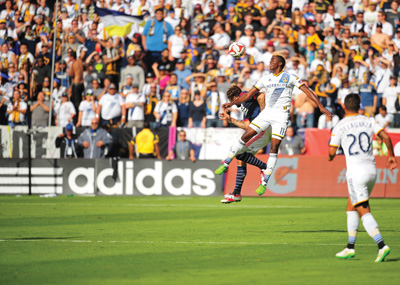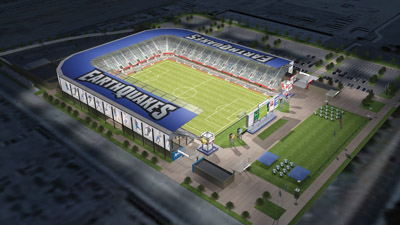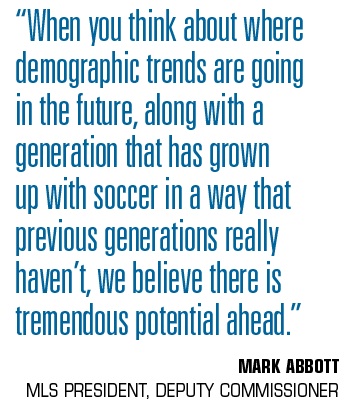When Don Garber worked for the NFL, he had a briefcase made out of Wilson game ball leather with a big league logo on it. He carried the briefcase everywhere and it often became a conversation piece.
“When we’d be traveling and you’d go and sit on a plane, invariably the guy sitting next to you after about 15 seconds would go, ‘What do you do? Do you work for the NFL?’” Garber said. “Then you had him talking about his favorite team and how cool it must be to work for the NFL.”
 |
MLS has attracted enthusiastic crowds to its matches, but still must find a way to increase viewership on television.
Photo by: ESPN Images |
Garber found that experience to play out a bit differently in the years after being named the second commissioner of Major League Soccer in 1999.
“I would sit next to people in that same situation on a plane and invariably people asked what I do, and I’d say I run Major League Soccer,” Garber said. “For so long the answer I’d most often get in return was why, with all these kids playing the sport, has soccer not made it in America?
“Now, I don’t get asked that question anymore. It’s quite the opposite in fact, and people have so much respect for what MLS has become, and that’s a far cry from when I joined the league.”
The coming 20th season might even be the league’s highest point yet.
This is the first season of MLS’s new eight-year media rights deal with Fox, ESPN and Univision that is priced more than five times higher than its previous deal (see story).
Two more teams will join the league, including a second team in New York with New York City FC, and with Orlando City SC, the league’s first Southeastern U.S. franchise since the Miami Fusion and Tampa Bay Mutiny clubs were folded after the 2001 season. The league will announce two more franchises in the coming months in its effort to have 24 clubs by 2020 (see story).
Attendance is also at its highest yet, with an average of 19,148 fans per game. The clubs’ stadium situations have
perhaps never been better — 14 of the league’s teams will play in their own soccer-specific stadium once the San Jose Earthquakes begin the season in their new home. Three other teams are making progress toward their own stadiums as well, with the New England Revolution and NYCFC in the exploratory stages, while D.C. United has received D.C. Council approval on a new development. Orlando City is on track to open its new stadium for the 2016 season.
The league also will begin to use its new logo for the first time, which it unveiled in September 2014.
But while this season will be a reason for much recognition of the strides the league has made, MLS believes there is much more room to continue to grow.
“Over this time, we have expanded our league strategically, we have excellent ownership groups, we have soccer stadiums in almost every market, we have terrific broadcast partners and, most importantly, we have what we never thought we’d have — a significant soccer culture in the U.S. and Canada, and that has put us in the position we are today,” Garber said.
“I did not think back then we would be where we are today, and while we’re still an emerging pro sports league both here and throughout the world, we’ve accomplished more than many thought we would.”
For MLS President and Deputy Commissioner Mark Abbott, no market still provides as big of an opportunity as the one right here in the U.S.
“For as much progress as has been made in the last 20 years, obviously we’re optimistic about the progress that has yet to come,” Abbott said. “When you think about where demographic trends are going in the future, along with a generation that has grown up with soccer in a way that previous generations really haven’t, we believe there is tremendous potential ahead.”
Abbott pointed to a number of decisions aided by Garber that have helped put the league’s growth into motion, such as the decision to expand carefully including into Canada, pursue strong media deals, make heavy investment in player development and infrastructure, and the idea that the league, through Soccer United Marketing, should get involved in other parts of the soccer business in this country.
“Even with how well things are going, we’re now at another turning point,” Abbott said. “Along with continuing stadium development, the on-the-field improvements with the plethora of American stars, greater numbers of international-born players than ever before, along with heavy investment in our development programs, it’s all coming together to launch our next era.”
 |
The San Jose Earthquakes are the latest MLS team to build a soccer-specific stadium.
Photo by: San Jose Earthquakes |
But while the future does hold promise, there are issues that still are hampering the league. Television viewership has been sluggish. The league has spent most of the offseason in a labor battle with the players union over free agency. Garber has also previously stated that MLS and its teams have lost more than $100 million combined in the last year.
Abbott said that while the league still does incur losses, all those involved with MLS believe that the league can be financially stronger through investment. “One of the things I think about the growth over the last 13 years is can we project that out over the next 13 years, and where will we be at then? I think at a very strong place,” he said.
U.S. Soccer Federation President Sunil Gulati is in a unique position to look at the growth of MLS. The original deputy commissioner of the league, Gulati left that position in 1999 but remains in close contact with Garber in his current role and the USSF has a relationship with the league via SUM.
“If you could turn the clock back to 1995 and say this is what it’ll look like in 20 years, would you take that? The answer would be absolutely yes,” Gulati said. “Does that mean we’re satisfied with where things are, 20 years in? I think there’s even more growth ahead.”
It will be a different kind of growth, Gulati said, given that the league simply won’t be able to go from 10 to 20 teams like it has from its initial season, but one that further ingrains the sport in the minds of fans.
“You’ll know the league has really reached the next level of progression when the quality of the game gets even higher and it becomes even further part of the fabric of American society,” he said. “Tradition takes time, and we’ve built a great start to a tradition, but given where we’ve started and where we’ve come, it’s certainly in a great position to go even further — no one asks if soccer is going to make it in the U.S. anymore, and no one asks if MLS will still be around in 10 to 12 years.”
When Garber made his first presentation to the MLS board in the fall of 1999, he talked about the enormous promise for soccer in America, and how the league could lead that effort, as well as capture the ongoing demographic shifts in the country.
“If we were focused and committed to creating a soccer nation in our country, we felt ultimately Major League Soccer would be a success,” Garber said. “For me 15 years later, that soccer nation has arrived, and I couldn’t be more excited for the future.”






